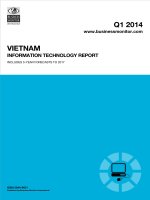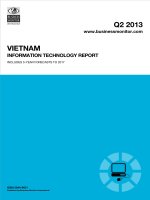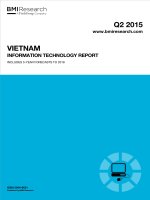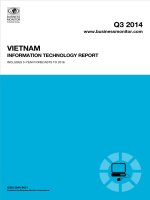United states information technology report q2 2014
Bạn đang xem bản rút gọn của tài liệu. Xem và tải ngay bản đầy đủ của tài liệu tại đây (502.46 KB, 103 trang )
Q2 2014
www.businessmonitor.com
UNITED STATES
INFORMATION TECHNOLOGY REPORT
INCLUDES 5-YEAR FORECASTS TO 2018
ISSN 2042-4205
Published by:Business Monitor International
United States Information
Technology Report Q2 2014
INCLUDES 5-YEAR FORECASTS TO 2018
Part of BMI’s Industry Report & Forecasts Series
Published by: Business Monitor International
Copy deadline: March 2014
Business Monitor International
Senator House
85 Queen Victoria Street
London
EC4V 4AB
United Kingdom
Tel: +44 (0) 20 7248 0468
Fax: +44 (0) 20 7248 0467
Email:
Web:
© 2014 Business Monitor International
All rights reserved.
All information contained in this publication is
copyrighted in the name of Business Monitor
International, and as such no part of this
publication may be reproduced, repackaged,
redistributed, resold in whole or in any part, or used
in any form or by any means graphic, electronic or
mechanical, including photocopying, recording,
taping, or by information storage or retrieval, or by
any other means, without the express written consent
of the publisher.
DISCLAIMER
All information contained in this publication has been researched and compiled from sources believed to be accurate and reliable at the time of
publishing. However, in view of the natural scope for human and/or mechanical error, either at source or during production, Business Monitor
International accepts no liability whatsoever for any loss or damage resulting from errors, inaccuracies or omissions affecting any part of the
publication. All information is provided without warranty, and Business Monitor International makes no representation of warranty of any kind as
to the accuracy or completeness of any information hereto contained.
CONTENTS
BMI Industry View 7
SWOT 9
IT SWOT 9
SWOT 11
Political 13
Economic 14
Business Environment 15
Industry Forecast 16
Table: US IT Industry - Historical Data And Forecasts (US$mn unless otherwise stated) 16
Broadband 21
Table: Telecoms Sector - Internet - Historical Data & Forecasts 21
Macroeconomic Forecasts 23
Table: United States - Economic Activity 31
Industry Risk Reward Ratings 32
Table: Americas Risk/Reward Ratings, Q2 2014 34
Market Overview 35
Hardware 35
Software 42
Services 48
Industry Trends And Developments 51
Regulatory Development 55
Table: IT Regulatory Authorities 55
Competitive Landscape 57
Local Companies 57
Table: CA Technologies 57
Table: Splunk 58
Table: Symantec 59
Table: EMC Corporation 60
Company Profile 61
Hewlett-Packard 61
Dell 68
Microsoft Corporation 74
IBM 82
Table: IBM Acquisitions, 2012 (Total Value, US$3.964bn) 85
Table: IBM Most Recent Acquisitions 85
United States Information Technology Report Q2 2014
© Business Monitor International Page 4
Regional Overview 90
Demographic Forecast 94
Table: The United States' Population By Age Group, 1990-2020 ('000) 95
Table: The United States' Population By Age Group, 1990-2020 (% of total) 96
Table: The United States' Key Population Ratios, 1990-2020 97
Table: The United States' Rural And Urban Population, 1990-2020 97
Methodology 98
Industry Forecast Methodology 98
Sources 99
Risk/Reward Ratings Methodology 100
Table: It Risk/Reward Ratings Indicators 101
Table: Weighting Of Components 102
United States Information Technology Report Q2 2014
© Business Monitor International Page 5
BMI Industry View
BMI View: The outlook for US IT spending remains strong relative to the majority of developed markets
over the medium term, as a result of stronger economic performance and a greater appetite from
enterprises for the latest products and solutions. Cloud computing, real-time enterprise software, security
and big data are all areas of spending in which we expect to see rapid growth. We also expect continued
demand growth for tablets in the retail market; however, desktop and notebook sales continue to be
squeezed. There is also potential for deeper fiscal retrenchment to hit government IT spending. The NSA
PRISM scandal continues to produce fallout amid concerns about data security in the cloud computing
market. Total spending is expected to reach US$622bn in 2014, up 5.9% from 2013, and grow at a CAGR of
4.3% to 2018.
Headline Expenditure Projections
■
Computer Hardware Sales: US$152bn in 2013 to US$157bn in 2014, an increase of 3.9%. Booming
tablet sales are driving growth while desktop and notebook sales are under continuing pressure from
cannibalisation.
■
Software Sales: US$173bn in 2013 to US$184bn in 2014, an increase of 6.4%. Emerging technologies
such as machine-to-machine and big data are being adopted by enterprises, while demand for cyber
security solutions is also an area of growth.
■
IT Services Sales: US$263bn in 2013 to US$280bn in 2014, an increase of 6.4%. Cloud computing
adoption is already high in the US but we expect strong growth to continue over the medium term despite
security concerns following on from the NAS Prism debacle.
Key Trends & Developments
The US retail hardware market fared better than other developed markets in 2013 as sales of tablets boomed
while the squeeze on desktop and notebook sales was less pronounced, particularly compared with Europe,
where economic crisis has added to the detrimental impact of tablet cannibalisation. Overall tablet sales
continue to drive the hardware market, with the latest data from Pew Research Centre showing penetration
reached 34% of the adult population in May 2013, up from just 14% a year earlier. Although tablets offer
continued growth potential as penetration rates rise, we expect growth to slow. Vendors will need to offer
new features and more competitively priced products if consumers are to accept short replacement cycles
and upgrade devices in quantities sufficient to offset the slowdown in first-time sales.
Cloud computing has been a leading theme in the US IT market in recent years as local enterprises have
adopted more complex solutions; however, the market is subject to uncertainty as a result of revelations
United States Information Technology Report Q2 2014
© Business Monitor International Page 7
around the National Security Agency (NSA) PRISM intelligence gathering programme. Surveys in 2013
showed that the scandal has hurt the prospects of US cloud providers internationally, most notably in
Europe. However, the domestic market appears to be relatively unscathed. Nonetheless, cloud providers
remain concerned about the impact of the government's activities on their growth prospects in a rapidly
developing market.
United States Information Technology Report Q2 2014
© Business Monitor International Page 8
SWOT
IT SWOT
SWOT Analysis
Strengths
■
The largest IT market in the world, with spending forecast to reach about US$726bn
by 2018.
■
The US is the largest centre of global IT innovation, home to many leading
companies, while most other global firms also have a research and retail presence.
■
Despite the challenging trading conditions, overall IT spending is still expected to
remain in positive growth territory.
■
PC shipments have held up better than in other developed markets in 2013 and are
forecast to do so in 2014.
Weaknesses
■
In the wake of the recession and subsequent slow economic recovery, customers
have postponed IT investments and reduced short-term spending, particularly in
areas such as consulting and software development.
■
Desktop and notebook sales appear to be in long-term decline due to longer
replacement cycles and the preference for mobile devices including tablets,
smartphones, smart TVs and convertibles/hybrids.
Opportunities
■
Technologically savvy local population willing to spend on premium devices, with the
US a particularly strong market for Apple's iPad and MacBooks.
■
As economic woes ease, IT vendors should see more growth from traditional big-
spending sectors such as banks, financial services, retail and manufacturing, where,
for example, take up of Windows 8 has been slow. Microsoft support of Windows XP
ceases in Q214, which should significantly accelerate W8 adoption by business users
during 2014.
■
Potential for growth in the hardware market through form factor evolution ie ultra-thin
notebooks, hybrids/convertibles and tablets.
United States Information Technology Report Q2 2014
© Business Monitor International Page 9
SWOT Analysis - Continued
■
Cloud computing, with a large number of federal and state cloud computing
programmes generating opportunities.
■
New business models such as software as a service and virtualisation will continue to
claim a large share of IT budgets.
■
Growth from emerging technologies such as Big Data and machine-to-machine
communications will drive innovation and spending.
Threats
■
Enterprise and consumer concerns around data security and privacy could prove a
drag on adoption of cloud services and big data solutions.
■
Privacy and cyber security became more pressing issues with the PRISM spying
revelations. This is expected to damage US cloud computing providers.
■
The large federal budget deficit could lead to pressures on public sector IT spending.
United States Information Technology Report Q2 2014
© Business Monitor International Page 10
SWOT
United States Wireline SWOT Analysis
Strengths
■
A large proportion of households continue to have a fixed-line connection.
■
Broadband growth remains robust despite a declining fixed-line market and
fluctuating pay-TV subscriptions.
■
Demand for faster speeds is leading to new technologies being introduced by
operators.
■
Connect America Fund is seeking to expand coverage.
Weaknesses
■
Fixed-line decline has been happening for over a decade. In 2013 it has been faster
than anticipated and no real respite is expected.
■
Even in cases of fixed-line subscriber growth, revenue and minutes of use are both
down.
■
Sluggish growth in broadband penetration despite high levels of public sector
investment.
■
Despite Obama's US$7.2bn investment in improving broadband connectivity,
deployment has been slow and a significant proportion of the population remains
underserved.
■
New technologies such as WiMAX and LTE will cannibalise fixed broadband market.
Opportunities
■
Wireline broadband continues to offer faster download speeds than wireless options,
making it more attractive prospect for many clients.
■
Broadband growth remains steady, if unspectacular, and the relatively low
penetration rate means it should continue in this vein.
■
IPTV growth highlights opportunities for operators to bring subscribers over a single
network offering considerable cost savings.
United States Information Technology Report Q2 2014
© Business Monitor International Page 11
United States Wireline SWOT Analysis - Continued
Threats
■
Problems in US economy are driving subscribers to mobile substitution faster than
ever, leading to a faster decline as subscribers look to reduce their outgoings.
■
LTE means the fixed broadband market will become increasingly redundant.
■
Weaker dollar has made the cost of contracts higher from external vendors.
■
Consolidation is likely to occur as Charter Communications aggressively reviews
takeover targets.
United States Information Technology Report Q2 2014
© Business Monitor International Page 12
Political
Political SWOT Analysis
Strengths
■
The US is an undisputed superpower and therefore occupies centre stage in most
international diplomacy.
■
A long-standing democracy with vigorous and open political debate, the US
continues to attract large numbers of immigrants committed to citizenship and self-
advancement.
Weaknesses
■
Political debate between Republicans and Democrats has historically been polarised
and divisive.
■
As today's superpower, the US attracts the enmity of a wide range of political groups
opposed to the current international status quo.
Opportunities
■
The widespread dissatisfaction of the voting public with the performance of Congress
may encourage both major parties to experiment with more consensual approaches
to certain policy areas.
Threats
■
The perception of inflexibility and bias in US foreign policy, particularly in the Middle
East, may stiffen opposition and at worst provide fertile recruiting ground for radical
anti-US groups such as al-Qaeda. Partly as a reaction to foreign policy difficulties, US
public opinion may return to an isolationist and protectionist mode.
United States Information Technology Report Q2 2014
© Business Monitor International Page 13
Economic
Economic SWOT Analysis
Strengths
■
The world's largest economy, with an impressive record of entrepreneurial dynamism
and innovation, and high research and development spending.
■
Despite some threats to its reserve status, the US dollar is treated as an international
currency, meaning investors around the world are prepared to hold US debt. Because
of this, the US is uniquely able to run large fiscal and current account deficits.
Weaknesses
■
Despite the dollar's role as an international currency, excessive US debt levels are a
risk. A decision by the Japanese and Chinese central banks to reduce their larger
dollar holdings could cause sharp falls in the value of the US currency.
■
A low savings rate by US households on a historic basis, although this has begun to
reverse.
Opportunities
■
Further liberalisation of international trade through the WTO, coupled with a more
competitive dollar exchange rate, could boost export growth and help restore balance
to the US's external imbalances.
Threats
■
Intensified competition from China and other low-wage economies could accelerate
the loss of manufacturing jobs.
■
Long-term budget imbalances, if left unaddressed, could eventually require an abrupt
cut back in spending that would weigh on economic growth.
United States Information Technology Report Q2 2014
© Business Monitor International Page 14
Business Environment
SWOT Analysis
Strengths
■
The US boasts the world's largest single internal consumer market, which presents
tremendous opportunities for businesses of all types and sizes.
■
Few countries offer a better environment for entrepreneurial activity, with a highly
flexible labour force, a legal system that is friendly to business, and significant centres
of technological innovation (such as California's Silicon Valley).
Weaknesses
■
Much of the physical infrastructure is in need of improvement, with congested roads
and airways.
■
US corporate tax is, on average, among the highest in the OECD (though effective
taxes are much lower).
Opportunities
■
The US has often been the origin of new drivers of economic growth booms, and
sectors ranging from biotechnology to alternative energy are being discussed as
possible catalysts.
Threats
■
The US's chronic fiscal deficits may force the federal government to find ways to raise
effective corporate tax rates, following a multi-decade downtrend.
United States Information Technology Report Q2 2014
© Business Monitor International Page 15
Industry Forecast
Table: US IT Industry - Historical Data And Forecasts (US$mn unless otherwise stated)
2011 2012 2013e 2014f 2015f 2016f 2017f 2018f
IT Market Value 529,329 551,031 587,620 622,113 654,649 681,490 705,410 726,008
o/w Hardware 141,478 144,679 151,506 157,450 162,574 165,993 168,459 169,920
- PC 114,880 118,636 125,447 130,369 134,611 137,442 139,484 140,694
- Servers 12,733 13,021 13,636 14,171 14,632 14,939 15,161 15,293
o/w Software 152,976 160,626 172,760 184,456 195,740 205,469 214,445 222,522
o/w Services 234,875 245,727 263,353 280,206 296,335 310,028 322,506 333,567
IT Market, % of GDP 3.4 3.4 3.4 3.4 3.5 3.5 3.4 3.4
e / f = BMI estimate/forecast. Source: BMI
BMI forecasts US spending on IT products and services will reach US$622.1bn in 2014, an increase of
5.9% over 2013, and then reach US$726bn by 2018. Despite the maturity of the IT market in the US, we
identify medium-term growth potential in sales of tablets, ultra-thin notebooks and hybrids/convertibles, as
well as adoption of cloud computing, big data and machine-to-machine (M2M) communications in the
enterprise market. These growth trends will support a CAGR of 4.3% from 2013 to 2018.
United States Information Technology Report Q2 2014
© Business Monitor International Page 16
2014 Outlook
The IT market in the US is highly developed, meaning growth will be slower than the faster-growing
emerging markets. However, when compared with its developed market peers, the US market is expected to
continue to perform well. US economic growth for 2014 is predicted to be in the 2.5-3% range. BMI
forecasts real-term private final consumption growth of 2.5% in 2014, which is a positive for the retail
hardware market as rising incomes and progress made by consumers in deleveraging boosts confidence.
Government expenditure is forecast to remain static in real terms in 2014, with modest growth forecast for
2015.
One area of public sector spending that will continue to grow is cloud services, for which there are expected
to be many more contracts with the continued implementation of the federal government of its Cloud First
cloud migration strategy. Departments such as the US General Services Administration are already making
significant use of cloud services, as the government seeks to make savings in its US$80bn IT budget. The
recession may have had a lasting impact on the IT market by encouraging consideration of cloud computing
models such as software-as-a-service (SaaS).
There hardware market had a mixed performance in 2013. Tablet sales boomed in 2013 despite rising
penetration as consumers seem willing to accept much shorter replacement cycles compared with traditional
form factors. Meanwhile, desktop and notebook shipments were declining. PC shipments (excluding tablets)
declined by around 1.5% year-on-year (y-o-y) to Q213 as consumers continue to exhibited a preference for
tablets. There had been some hope on the part of vendors that the release of Microsoft's Windows 8 OS in
October 2012 would lead to increased sales of desktops and notebooks; however, the boost has not lived up
to vendors' hopes. However, there is potential for significantly increased uptake of Windows 8 in 2014 as
Microsoft ceases support for Windows XP in Q214. Traditionally conservative business consumers will be
forced to undertake operating system upgrades. BMI believes hybrids/convertibles and ultra-thin touch-
screen notebooks have the potential to experience rapid growth, but with momentum only beginning to
build in 2013, the impact will be felt more strongly later in our forecast period.
Enterprise spending on IT should experience moderate growth in 2014 as confidence begins to return.
However, while there is pent-up demand from projects delayed as a result of the economic situation, some
of this may not now be realised. The growing market for cloud solutions and virtualisation will constrain
demand for on-premises computer networks. Regardless of the exact strength and nature of the recovery, the
current economic environment will offer some opportunities to vendors.
United States Information Technology Report Q2 2014
© Business Monitor International Page 17
Drivers
Investments in supporting infrastructure will boost IT market spending over the medium term. Telecom
operator investments in mobile and fixed broadband infrastructure will help to boost retail sales of
hardware, particularly mobile PCs such as tablets and hybrids/convertibles. These investments also enable
adoption of cloud computing services by consumers and small and medium-sized enterprises (SMEs) that
are not in large urban areas already served by high-quality telecoms infrastructure.
BMI has a bright outlook for the M2M market, or Internet of Things, which is a medium-term opportunity
for IT software and service providers to partner with telecoms operators. In 2013, leading software and
services firms, including SAP and Wipro, partnered with M2M communications providers to tap growth in
the nascent market. US mobile operators are among the global leaders in the deployment of M2M services,
with verticals such as utilities, security, asset tracking, vehicle infotainment and other smart services targets
for growth. We believe software and services firms will benefit either though partnerships with operators or
by selling to them direct.
Another area of growth is the cloud computing market, with surveys showing high levels of satisfaction
with cloud services among US CIOs. Vendors are now rolling out more customised SaaS solutions for
SMEs. The roll-out of more service offerings, including from new market players, will fuel
demand.However take-up may be adversely affected by fallout from the NAS Prism scandal. Virtualisation
is making headway and will continue to do so, and it is proceeding to more and more parts of the
datacentre. Another growth opportunity will be private and public sector organisations looking for help to
utilise efficiencies from cloud computing models such as SaaS and Infrastructure-as-a-Service (IaaS). The
federal government's Cloud First initiative is one of a number of federal and local government agency cloud
migrations and pilot programmes.
The economic downturn may also have accelerated the growth of outsourcing of non-core processes and a
shift. Already, more and more software development has been outsourced to India and other locations, and
vendors will be able to make the case that external spending on IT solutions can help the bottom line and
add to efficiency.
Segments
The government remains a key end-user despite pressure on fiscal expenditure. Federal IT spending reached
a level of around US$80bn as departments continue to issue IT tenders despite a drive to make savings
through closing hundreds of federal datacentres in 2012-2015. New government programmes, including the
United States Information Technology Report Q2 2014
© Business Monitor International Page 18
expansion of healthcare, should generate lucrative new opportunities for IT vendors, although because of
the ever-growing budget deficit, there will be increased pressure to reduce costs.
With economic growth now underway, IT vendors should experience more growth from traditionally big-
spending sectors such as banking, financial services, retail and manufacturing. BMI expects financial
services will be a key spending vertical as new regulations require increased investment, and in addition, the
increasing cyber security threat facing them will force further investment in services and solutions. The
advent of mobile payment systems will be an additional source of spending growth.
Small businesses are also a target for vendors. There are more than 8mn small businesses in the US, which
is a substantial market. However, there are significant differences between the needs of businesses in
different industries. Increasingly, vendors will need to customise approaches based on industry-specific
needs.
United States Information Technology Report Q2 2014
© Business Monitor International Page 19
Summary
The hardware market is predicted to grow from US$157.5bn in 2014 to US$170bn in 2018. Software
spending should rise from US$184.5bn to US$222.5bn, and IT services from US$280bn to US$334bn, over
the forecast period.
Industry Trends - IT Market
2011-2018
2011
2012e
2013e
2014f
2015f
2016f
2017f
2018f
0
250,000
500,000
750,000
1,000,000
f = BMI forecast. Source: BMI
United States Information Technology Report Q2 2014
© Business Monitor International Page 20
Broadband
Table: Telecoms Sector - Internet - Historical Data & Forecasts
2011 2012 2013e 2014f 2015f 2016f 2017f 2018f
No. of internet users ('000) 218,965 236,503 249,389 256,090 266,784 271,529 273,973 276,164
No. if internet users/100 inhabitants 69.5 74.5 77.9 79.4 82.1 82.9 83.0 83.0
No. of broadband internet
subscribers ('000) 84,870 91,668 97,038 99,646 103,807 106,066 107,021 107,877
No. of broadband internet subscribers/
100 inhabitants 27.0 28.9 30.3 30.9 31.9 32.4 32.4 32.4
e/f = BMI estimate/forecast. Source: BMI, FCC
New data from the FCC show there were 91.668mn
fixed broadband subscribers in the US at the end of
2012, alongside 170.076mn mobile broadband
subscribers. The FCC's definition of broadband uses
data transfer rate benchmarking that is not wholly
consistent with that employed elsewhere in the
world. Nevertheless, it is clear from the FCC's data
that the most significant growth in broadband is in
the wireless arena and that, as has been seen in other
mature markets worldwide, the greater flexibility of
mobile relative to fixed connections is causing some
xDSL customers to 'cut the cord'.
The fixed broadband market remains buoyant mainly
due to cable and fixed wireless usage, which remains
strong, as well as to a small but growing base of
fibre accesses. BMI forecasts the number of fixed
broadband connections to reach 97.038mn by the end of 2013, rising to 107.8mn by 2018.
High-speed internet is central to the marketing strategies of telecoms operators, with cable companies and
mobile operators pursuing the high revenue area. At the same time, the sheer popularity of internet-based
services means that the point is fast approaching when most Americans will view such services as being
Industry Trends - Internet
2011-2018
Internet users, '000 (LHS)
Broadband internet subscribers, '000 (RHS)
2011
2012
2013e
2014f
2015f
2016f
2017f
2018f
0
100,000
200,000
300,000
0
20,000
40,000
60,000
80,000
100,000
120,000
e/f = BMI estimate/forecast. Source: BMI. Operators, FCC
United States Information Technology Report Q2 2014
© Business Monitor International Page 21
essential to their daily lives. The Broadband Technologies Opportunities Program backs up this view and
efforts to extend broadband services into rural areas will ensure that this trend continues, particularly as
service providers and content developers/vendors grow their product portfolios and become more adept at
marketing and pricing content that appeals to a broad range of consumers. Similarly, the FCC's National
Broadband Plan aims to ensure universal access, competition and the efficient allocation of spectrum to
benefit the broadband sector. Increased revenue derived from such activities will allow operators to expand
into new markets and it seems increasingly likely that fixed-line operators will need to become broadband-
focused in order to survive.
United States Information Technology Report Q2 2014
© Business Monitor International Page 22
Macroeconomic Forecasts
BMI View: Our view for gradual strengthening in the US economy through end 2014 continues to play out,
driven by a tightening labour market and sustained growth in the cyclical components of the economy,
notably the residential housing sector and business investment in equipment. Data have been particularly
strong in recent months, and we acknowledge that risks are weighted to the upside.
Macro Outlook: The US economy picked up steam in the second half of last year, in line with our view
that the economic recovery would find firm footing in 2013 and accelerate into 2014. Incremental labour
market improvement, a relatively stronger external environment, monetary stimulus from the US Federal
Reserve (Fed), and a cyclical uptick in the residential housing market have all played their part in 2013,
outweighing a considerable fiscal drag on real GDP growth from the US federal government budget
sequester went into effect. Additionally, having reviewed high frequency data through most of Q413, it is
becoming apparent that the October 2013 federal government shutdown was a considerable hurdle, but did
not derail the economic recovery. We see these trends continuing, and in some cases accelerating, through
the end of 2014.
United States Information Technology Report Q2 2014
© Business Monitor International Page 23
Growth To Pick Up In 2014
US - Real GDP Growth, SAAR %
Note: e=BMI estimate, f=BMI forecast; Source: BEA, BMI
The ISM PMI ended 2014 on a high note, suggesting that fourth quarter growth could come in quite strong,
posing some upside risk to our 2013 real GDP growth estimate of 1.8%. Indeed, if Q413 real GDP growth
were to equal the 4.1% figure from Q313, 2013 growth would likely come in around 2.0%. Furthermore,
this would have substantial positive base effects for 2014, and we would likely revise up our forecast from
2.8%, where it currently stands, to 3.0 or 3.1%. However, 1.7 percentage points of the 4.1% growth
recorded in Q313 came from inventory building, which we believe unwound slightly Q4, offsetting strong
growth in the rest of the economy. As such, we are maintaining our 2013 estimate and 2014 forecast of
1.8% and 2.8% respectively, although we acknowledge risks weighted firmly to the upside in both cases.
United States Information Technology Report Q2 2014
© Business Monitor International Page 24
PMI Shows Strengthening Economy
US - Real GDP Growth, SAAR % & ISM PMI (3-Month MA)
Source: BMI, BEA, FRED
Expenditure Breakdown
Private Consumption: The broad trends supporting stronger real personal consumption expenditure (PCE)
growth remain in place, and as such we expect real PCE growth to continue to accelerate in 2014. The
monthly change in nonfarm payrolls is hovering between 150,000 and 200,000, a level we believe is
sufficient to lead to a further reduction in the unemployment rate. Additionally, consumer confidence is near
post-financial crisis highs, having largely recovered after the October 2013 federal government shutdown.
Indeed, spending accelerated to 3.5% year-on-year (y-o-y) in November 2013, the strongest growth rate
over the year, and we maintain our view that real PCE growth will accelerate to 2.5% in 2014 from our
estimate of 2.2% last year.
United States Information Technology Report Q2 2014
© Business Monitor International Page 25









